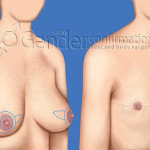 Getting to know your FTM incision options: Finding the Perfect Match
Getting to know your FTM incision options: Finding the Perfect Match
Medically reviewed by Dr. Scott Mosser on September 13, 2024.
A female to male (FTM) top surgery aims to create a flat, male-looking chest. At Dr. Mosser’s top surgery clinic, we do more than just that.
Our mission is to help you feel comfortable with your physical appearance so you’d be able to live in a way that best matches your identity. We treat you the way we want to be treated if we’re in your shoes.
By the end of this blog post, you will be savvy enough to determine the different incision types used in your FTM top surgery.
It All Begins With Research
While testosterone can significantly reduce and slightly alter the shape of your chest, it won’t make breast tissue completely go away. This is why surgery is the best alternative.
In 2014, Fred McConnell wrote a wonderfully honest piece on The Guardian about his FTM top surgery and transformation. Here’s an excerpt of the post:
I also researched surgeons. There are dedicated websites to which people can upload their results picture, as well as Facebook groups and YouTube channels. Post-op guys essentially peacock as a community service. Pre-op guys study their results and leave admiring comments. I felt lucky to be alive at a point in history when this was even possible.
Such an inspiring story, yes?
We particularly liked McConnell’s emphasis on research. He achieved his FTM desired results because he made the decision to have surgery after carefully weighing his options and learning what to expect from the FTM procedure. This is one of the hallmarks of a good gender confirmation candidate.
If you’re thinking about FTM chest surgery, learning about the different surgical techniques is one aspect of the surgery that you should carefully examine. We explain them in jargon-free language below!
Quick Guide to FTM Incision Options
- Do you have medium to large chest (cup size C and above) and significantly sagging skin?
A double incision top surgery is the perfect fit to help reconstruct male chest contours and appropriately positioned nipples.
Quick note: Keep in mind that sensation may not return in the areola (the pigmented skin around the nipple) or nipple because the nerves are cut when the nipple or areola is removed.
- Do you have medium to large chest and with significant sagging skin but would like to retain sensation?
An inverted T (anchor) incision keeps the nipple and areola attached to native body tissue, reducing the risk of complete nipple loss (since there is no need for a nipple graft), and having a nipple and areola that are fuller in appearance.
Quick note: In this incision, you have to be comfortable with having two extra vertical incisions.
- Do you have medium-sized chest, has good skin elasticity, and would like to retain areola and nipple sensation?
Opt for the circumareolar incisio! In this type, a circular incision is made all the way around the edge of the areola to remove breast tissue. A slightly larger incision in the form of a ring is then made to remove excess skin. The skin is pulled toward the center and the nipple is reattached to cover the opening
Quick note: Revision may be required for this type of incision such as additional liposuction.
- What if you have small-sized breasts and has good skin elasticity?
The keyhole top incision is highly recommended. A tiny incision is made under or across the lower border of the areola.
Quick note: A keyhole incision can remove underlying tissue but it cannot address excess skin.
- What if I have very small chests?
You’re a candidate for liposuction incision. requires only a very small incision that can often be concealed near the armpits. Incisions are usually about 4 mm in length and result in minimal scarring. This technique is often used in conjunction with the aforementioned techniques.
How do I determine the best FTM incision type for me?
Our website and other online resources can be informative regarding the different incision types for your female to male top surgery.
However, these are not a substitute for a proper, comprehensive discussion and physical examination with a board-certified plastic surgeon who is trained and experienced in transgender top surgery. Get a free consultation with an experienced surgeon now!




